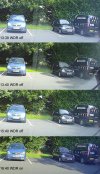yes I'm familiar with the other issues, the WDR with 50Hz problem is a separate issue, when set to 50Hz it still behaves like it does at 60Hz so even if you set it to 50Hz you wouldn't see the problem as your power is 60Hz, for those of us in 50Hz power areas the results when there is any artificial lighting about are very poor, something they've been made aware of and they're working on it
the type of WDR they are using has some distinct advantages but it also has a lot of challenges, expect it will take a lot of work to get it sorted













